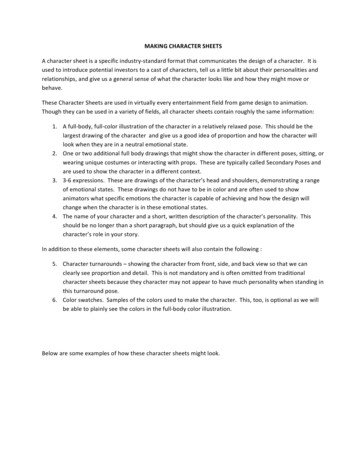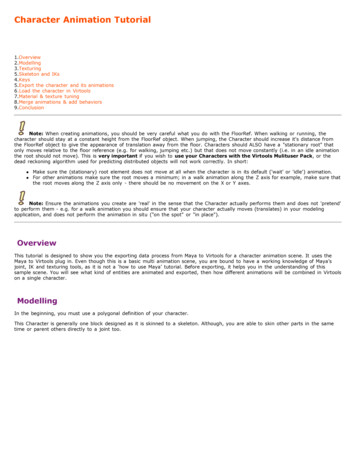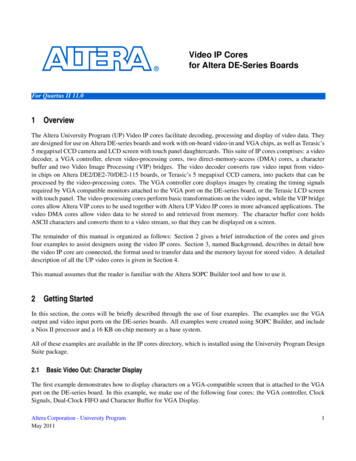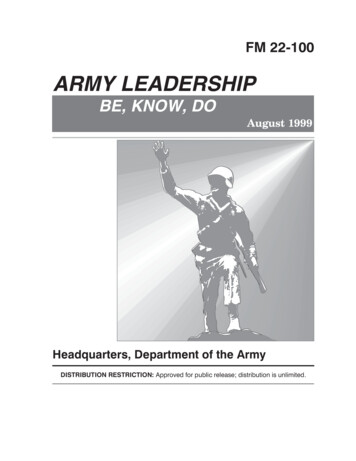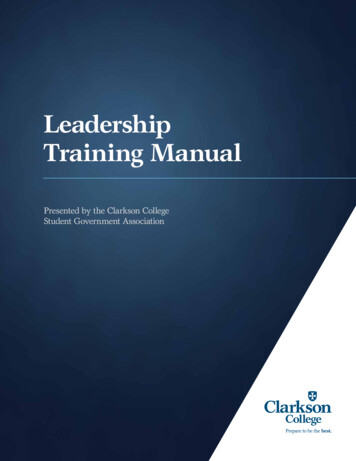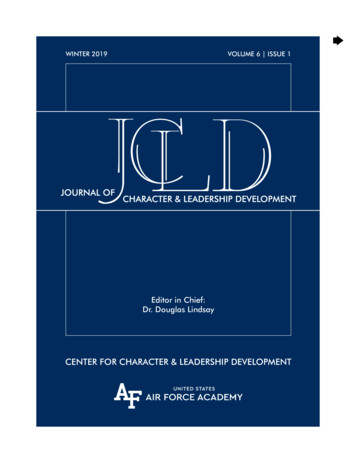
Transcription
WINTER 2019VOLUME 6 ISSUE 1Editor in Chief:Dr. Douglas LindsayCENTER FOR CHARACTER & LEADERSHIP DEVELOPMENT
EDITORIAL STAFF:Dr. Mark Anarumo,Managing Editor, Colonel, USAFDr. Douglas Lindsay,Editor in Chief, USAF (Ret)Dr. John Abbatiello,Book Review Editor, USAF (Ret)Ms. Julie Imada,Editor & CCLD Strategic Communications ChiefJCLD is published at the United States AirForce Academy, Colorado Springs, Colorado.Articles in JCLD may be reproduced in wholeor in part without permission. A standardsource credit line is required for each reprintor citation.For information about the Journal of Characterand Leadership Development or the U.S. AirForce Academy’s Center for Character andLeadership Development or to be added to theJournal’s electronic subscription list, contactus at:JCLD@usafa.eduPhone: 719-333-4904The Journal of Character & LeadershipDevelopmentThe Center for Character & LeadershipDevelopmentU.S. Air Force Academy2300 Cadet DriveSuite 300USAF Academy, CO 80840-62600ISSN 2372-9465 (print)ISSN 2372-9481 (online)Manuscripts may be submittedvia Scholastica IAL BOARD:Dr. David Altman, Center for Creative LeadershipDr. Marvin Berkowitz, University of MissouriSt. LouisDr. Dana Born, Harvard University (Brig Gen,USAF, Retired)Dr. David Day, Claremont McKenna CollegeDr. Shannon French, Case WesternDr. William Gardner, Texas Tech UniversityMr. Chad Hennings, Hennings Management CorpMr. Max James, American Kiosk ManagementDr. Barbara Kellerman, Harvard UniversityDr. Robert Kelley, Carnegie Mellon UniversityMs. Cathy McClain, Association of Graduates(Colonel, USAF, Retired)Dr. Michael Mumford, University of OklahomaDr. Gary Packard, United States Air ForceAcademy (Colonel, USAF)Dr. George Reed, University of Colorado atColorado Springs (Colonel, USA, Retired)Dr. Eduardo Salas, Rice UniversityDr. Arthur Schwartz, Widener UniversityDr. John Sosik, The Pennsylvania State UniversityDr. Steve Trainor, The Google School for Leaders(Captain, USN, Retired)Dr. Steve Zaccaro, George Mason UniversityThe Journal of Character & LeadershipDevelopment is generously supported by theUnited States Air Force Academy Endowment.
JCLD / TABLE OF CONTENTSFROM THE EDITORSReflections on Leadership, Teamwork & Organizational ManagementMark Anarumo, United States Air Force Academy3Douglas R. Lindsay, United States Air Force AcademyNATIONAL CHARACTER & LEADERSHIP SYMPOSIUMMoving Beyond the Status Quo: Leveraging the “Leadership, Teamwork,& Organizational Management” Outcome at the U. S. Air Force Academyto Improve Leadership Education and TrainingGary Packard, United States Air Force AcademyLEADERSHIPMy Investment in CharacterMax James, American Kiosk ManagementLeading With and for Character: The Implications of Character EducationPractices for Military LeadershipElise Murray, Tufts University92033Marvin Berkowitz, University of St. LouisRichard Lerner, Tufts UniversityDeveloping Leaders of Character with Emotional IntelligenceDavid Caruso, Yale UniversityLisa Rees, LTR LeadershipFocus on the Locus: A Response to “The Rhetoric of Character and Implicationsfor Leadership” by George ReedGeorge Mastroianni, United States Air Force AcademyCharacter and Leadership: Ancient Wisdom for the 21st CenturyDana Born, Harvard UniversityWhat Makes a Good Team Leader?Denise L Reyes, Rice University5268Christopher Megone, University of LeedsTEAMWORK43Julie Dinh, Rice UniversityEduardo Salas, Rice University88
The Power of Enabling Humility in TeamsMelissa Norcross, United States Naval AcademyORGANIZATIONAL MANAGEMENTUnderstanding Complexity in Organizational ManagementWalter E. “Ted” Carter, Jr., Vice Admiral, USN102112Superintendent, United States Naval AcademyPreparing Military Professionals for the Moral Imperatives of 21stCentury WarfareJohn Abbatiello, United States Air Force Academy119Promoting Polyarchy and Professionalism in Officer Character andLeadership DevelopmentMatthew Valle, Elon University125Character Conflation: The Just War Tradition and Just PeacemakingTheory as Part of an Intentional Character Development ApproachDavid Murphy, Dallas Baptist University135Ervin Rokke, United States Air Force AcademyDavid Levy, United States Air Force AcademyBOOK REVIEWSBook Reviews for the JCLD150A Review of "Professionalizing Leadership"151John AbbatielloDavid HustonA Review of "How Good People Make Tough Choices: Resolving theDilemmas of Ethical Living"153Alex ButlerCALL FOR ARTICLES156SUBMISSION GUIDELINES157Disclaimer: The views and opinions expressed or implied in JCLD are those of the authors, are not officially sanctioned, anddo not necessarily reflect the official policy or position of the Air Force or any agency of the U.S. government.
REFLECTIONS ON LEADERSHIP, TEAMWORK & ORGANIZATIONAL MANAGEMENTFROM THE EDITORSReflections onLeadership, Teamwork& OrganizationalManagamentDr. Mark Anarumo, Managing Editor, JCLDDr. Douglas Lindsay, Editor in Chief, JCLDColonel Mark Anarumo is a Permanent Professor and Director of the Center for Character LeadershipDevelopment at the United States Air Force Academy. Prior to his current role, he was the Vice Commanderof the 39th Air Base Wing at Incirlik Air Base, Turkey. His previous assignments include command of 3squadrons, a National Security Fellowship at Harvard University, Chief of Programming for HeadquartersU.S. Air Force Directorate of Security Forces, Deputy Chief of Force Development at Air Combat Command,Executive Officer to the Air Combat Command Director of Security Forces, Chair of Homeland Security andTerrorism Studies, and Operations Officer for the largest deployed Security Forces Squadron in the world.Prior to entering the Air Force through ROTC, he served in the US Army as an M-1 Abrams tank crewman,reaching the rank of Corporal and tank commander. Colonel Anarumo is a graduate of the Federal Bureauof Investigations National Academy, U.S. Army Pathfinder School, the U.S. Army Air Assault School andearned a Bachelor of Science degree in Administration of Justice, a Master’s Degree in Criminal Justiceand a PhD in Criminal Justice all from Rutgers University.Dr. Douglas Lindsay is the Editor in Chief of the Journal of Character and Leadership Development(JCLD). Prior to assuming his current role, he was a Professor and the Founding Director of the Masters ofProfessional Studies Program in the Psychology of Leadership at The Pennsylvania State University. He alsoserved in the United States Air Force where he retired after a 22-year career, serving in a multitude of roles,including research psychologist, occupational analyst, inspector general, deputy squadron commander,senior military professor, Full Professor, deputy department head and research center director. He has over100 publications and presentations on the topic of leadership and leadership development. He receiveda Bachelor's Degree from the United States Air Force Academy, a Master's Degree from the University ofTexas at San Antonio, and a PhD in Industrial/Organizational Psychology from Penn State University.
THE JOURNAL OF CHARACTER & LEADERSHIP DEVELOPMENT / WINTER 2019The Journal of Character and Leadership Development(JCLD) exists to facilitate scholarship and dialoguearound the development of character and leadership. Onthe surface, that may seem a relatively straightforwardendeavor. In fact, there are many publications thatclaim to operate in different parts of that domain.The challenge, and why we have launched this journal,is sorting through the vast amounts of work that arepublished every year on both character and leadershipas independent concepts. As an example, a simplesearch through an academic search engine like GoogleScholar produces over 4 million results for the searchterm “leadership” and over 4.7 million results for“character.” That is an overwhelming number ofpublications to sort through. A leader focused on theirown development would face an arduous battle tryingto identify which information as most relevant to theirown personal development and circumstance. As aresult, many rely on recommendations from others orwhat catches their attention online or as they peruse abookstore. While this casual approach has the benefitof exposing one to different thoughts about leadership,it is far from an intentional developmental strategy thataligns with personal goals and accountability. The keyword in the previous sentence is intentional.As highlighted in the previous issue of the JCLD,development can occur without any intentionality;however, as we approach a complicated construct likecharacter and leadership and the complex interplaybetween the two, we should be keenly aware of whatdevelopment we are trying to achieve and not simplyleave it to chance. In fact, this is what the militaryservice academies (as well as other organizations witha focus on character development) are designed to do:Bring intentional experiences at the appropriate timeto produce growth in a certain area. This is where theCenter for Character and Leadership Development(CCLD), and by extension this journal, has its role.4CCLD provides intentional education, training, anddevelopment for USAFA with respect to characterAND leadership development. While the mission ofUSAFA may be at the cadet level, there are numerousopportunities for all faculty and staff to benefit from a“tour” at USAFA. This could be as a faculty memberteaching a course, a program lead responsible for cadetdevelopment, mentoring a cadet, or adding to thebody of scholarly research. All of those elements havedevelopmental effects for cadets, but should also bepart of an intentional developmental plan for facultyand staff.When we think about development, it shouldn’tjust be for one segment of our institution as we allhave an impact on and are impacted by what is goingon around us at USAFA. The focus of CCLD is toserve as the integrative function for the institution. Inorder succeed in that function, we must be willing toengage in dialogue that not only expands our thinkingbut is based in science and state of the art conceptualunderstanding of key concepts. That means we willoften come into contact with information that causesus to think about challenges and process in ways thatwe have not previously experienced. It is that nexuswhere learning and development can occur. It is also,fortunately, where the JCLD is positioned.In This IssueEvery year, since 1993, the United States Air ForceAcademy has hosted the National Character &Leadership Symposium (NCLS). This world-class,multi-day event brings together thought leaders,experts, students, military members, and many othersto intentionally focus on character and leadershipdevelopment. This is accomplished through panels,speeches and guided group discussions. It is the largestevent of its kind, attracting over 5,000 attendeesannually.
REFLECTIONS ON LEADERSHIP, TEAMWORK & ORGANIZATIONAL MANAGEMENTThe theme for this year’s NCLS is Leadership,Teamwork, & Organizational Management (LTOM)which also happens to be one of USAFA’s InstitutionalOutcomes. Due to the impact and scope of NCLS,as well as the previous discussion on intentionaldevelopment, we thought it would impactful to alignthis issue of the JCLD with NCLS. As a result, wehave collected a series of articles from thought leaderson various aspects of the LTOM outcome.The first article is by Gary Packard who is the ViceDean for Curriculum and Strategy at USAFA. Hedraws on his experience working with outcomes atUSAFA to describe LTOM, the challenges associatedwith such a broad outcome at a large university, andfinishes with some recommendations on how one canlead at different levels. This article is a great set up forNCLS and those who plan to attend as he gives practicaladvice on how we can grow as leaders. He also discusseshow we as an institution can use the LTOM outcometo continue to improve our processes and leadership.With this focus on LTOM, the rest of the JCLD isbroken into three sections: Leadership, Teamwork, andOrganizational Management. While an exhaustivecoverage of these three topics are beyond the scope ofany single issue of a journal, we have chosen articlesthat not only show the breadth of scholarship that isoccurring at each of these levels, but will also expandour thinking on the topics.LeadershipWe begin our discussion with five articles that describedifferent approaches to the study of leadership andcharacter. The first is an interview with Mr. Max James(USAFA Class of 1964), an ardent and early supporterof this Journal and CCLD. In the interview, Mr. Jamesdescribes the substantial investments he has made overthe years to focus on adolescent character development,his involvement with the building of Polaris Hall (thehome of the Center for Character and LeadershipDevelopment), and shares his thoughts on characterdevelopment. Mr. James describes on how one canshow character and leadership through their actions.The discussion on leadership continues with anarticle by Elise Murray, Marvin Berkowitz, andRichard Lerner. They offer a compelling discussionaround character education and how it can be utilizedto help individuals to lead with character. They do thisthrough describing the value of character educationand offering suggestions on how to create and sustaincharacter education programs. While this is donethrough the lens of military leadership, they write insuch a way that all organizations can benefit from theiradvice.Next, we move to a topic that has receivedsignificant attention over the past few years: EmotionalIntelligence. While much has been written, thereare conflicting narratives about what EmotionalIntelligence is and how it should be measured. DavidCaruso and Lisa Rees adeptly step through not onlywhat intelligence is (and what it isn’t), they provideadvice about the role of emotions in leadership andhow Emotional Intelligence may be used to developleaders of character. This thought provoking piece willcertainly expand the reader’s thoughts on this topic.Scholarship can take many forms. It can be anempirical examination of a particular topic or it couldalso be a description of what we know about a particularsubject area (i.e., a meta-analysis). In fact, there aremany ways to approach scholarship. The fourtharticle in this section is a perfect example of a scholarlydialogue between professionals. In the last issue ofthe JCLD, Dr. George Reed wrote a compelling piecetitled “The Rhetoric of Character and Implications forFROM THE EDITORS5
THE JOURNAL OF CHARACTER & LEADERSHIP DEVELOPMENT / WINTER 2019Leadership.” It was an insightful examination of thepower of the situation and how that can impact thepresence of character for individuals, military membersin particular. In this issue, George Mastroianni furthersthat discussion by challenging several assumptionsmade by Dr. Reed through an adept discussion ofhuman behavior. This is an excellent example of howtwo professionals can have different points of view ona topic, value each other’s perspectives, and walk awaywith a deeper understanding of each other’s pointsof view. All are hallmarks of effective leadership anddemonstrate high character.In leadership and character literature today, there isoften a focus on new theories, skills, and approaches thatmark the potential “next best thing” for leaders. Whilethis approach certainly has some merit, what is oftenmissing is an intentional tie back to previous work doneon different constructs. Dana Born and ChristopherMegone challenge us to consider that there is muchto learn from looking back as we look forward. Theydo an excellent job of referencing early philosophersto describe how some of those early works still haverelevance today in the discussion around character andleadership development. This educational approach is asuperb example of why education in the broader SocialSciences & Humanities, as well as Engineering andBasic Sciences, can provide a necessary foundation inour development of leaders of character.TeamworkThe second part of the LTOM outcome deals withteamwork. Clearly, it is evident why this would be animportant component to effective leadership withinan organization like the military; however, teams andteamwork are present at some level in every majororganization, university, and other occupationaldomains. Being able to understand teams, what makesthem effective, and how to successfully complete work6within teams is critical to the workplace of today.In order to shed some light on aspects of effectiveteamwork, we are proud to present two articles thatdescribe different components of teams. The firstarticle, by Denise Reyes, Julie Dinh, and Eduardo Salasdescribe what is meant by the leadership of teams. Theyfollow with a review of team literature and identifyseveral insights that can be taken from examining thatscholarship, in other words, what we currently know.They wrap up the article with recommendations forfuture research, a.k.a. what we still need to know, onteam leadership. This article does an excellent jobpulling together what we know to help inform were weneed to go regarding the science of teams and leadershipof teams.The next article by Melissa Norcross discusses therole that humility can have on teams. The articlebegins with a discussion of humility and what it lookslike in a team setting. She introduces four componentsof a humble team culture - attitude of inquiry,kinship, extraordinary collaboration, and professionalexcellence - and then describes the leader’s role increating and modeling humility for the team. Whilethe first team article talks about the leadership of teams,this article does more of deep dive into a component ofeffective team leadership. Both perspectives are criticaland important for the effective leadership of teams.Organizational ManagementThe third component of the LTOM outcome isorganizational management. This portion of theoutcome looks at the leadership of organizations andthe leader’s role in achieving effectiveness. This notonly applies to what the individual leader does (theiractions) but also the policies, procedures, and culturethat the leader puts into place. Since organizations aremade up of individuals, leaders, teams, departments,etc., leadership at the organizational level can have a
REFLECTIONS ON LEADERSHIP, TEAMWORK & ORGANIZATIONAL MANAGEMENTcascading effect throughout the rest of the organizationand therefore impacts leader effectiveness at all levels.For organizational leadership, we have a range oftopics that relate to different aspects of this part ofthe outcome.as a mechanism to help leaders be more effective in thechanging future environment. Through this approachthey offer several suggestions of how it can be leveragedto build more dynamic capability among the leaders inour organizations.The first article is an interview with Vice AdmiralWalter Carter, the Superintendent of the UnitedStates Naval Academy. In this interview he coversthe challenges and the rewards of leading a militaryservice academy, which he has done for nearly fiveyears. He discusses his experiences and the leadershipimplications for leading such a diverse organization.As Lt Gen Jay Silveria pointed out in the previousissue of JCLD, leading a military organization as wellas a university poses unique challenges. Through theinterview, Vice Admiral Carter provides some practicaladvice to those who lead at the organizational level.The final article, by David Murphy, offers a morefocused definition of character (referred to as characterconflation) and how it can be applied to the broad rangeof operations that militaries face. He discusses howthe Just War Tradition should be expanded to includeJust Peacemaking Theory. This theoretical discussionexpands the discussion of what character looks like inthe different roles in which we are asking our militarymembers to serve.The next article by John Abbatiello and Ervin Rokkedescribes some of the current challenges that militaryleaders face, and allude to those which they will facein the future. This examination of current and futurechallenges is used to frame a discussion of how we needto think more deeply about some of the moral challengesour future leaders will face. If we don’t thoughtfullyconsider how this will impact our educational andtraining pipelines, we will be ill prepared to effectivelywage future warfare.The third article by Matthew Valle and DavidLevy is a thoughtful discussion of how we need tobe organizationally thinking about character andleadership development in the future. They introducethe concept of polyarchy, which is “collaborationand decision-making in dynamic environments bybringing the necessary resources to bear quickly andefficiently so that focal individuals can sense and shapeopportunities quickly and make decisions proficiently”As evidenced by the broad spectrum of articles thathave been included in this issue of the JCLD, it is clearwe are just scratching the surface of these topics. Ourhope is that this diverse look at the LTOM topic willspur discussions not only after reading this issue, butalso as a compliment to experiences gained throughthis year’s NCLS speaker series whether live or throughour continuing discussion modules available online.Our challenge to you is to see how this informationcan help inform your own character and leadershipdevelopment regardless of what level of leadership youcurrently find yourself.Book ReviewsIn this issue of the JCLD, we are introducing a sectionfor book reviews. Our Book Review Editor, Dr.John Abbatiello, has expertly developed this sectionfor the JCLD. We are adding this section to providea venue through which relevant scholarship can behighlighted. We will be focusing on books that havedistinct application for the development of leadershipand character. There are two books reviewed in thisissue of the JCLD: Professionalizing Leadership byFROM THE EDITORS7
THE JOURNAL OF CHARACTER & LEADERSHIP DEVELOPMENT / WINTER 2019Barbara Kellerman, and How Good People MakeTough Choices: Resolving the Dilemmas of EthicalLiving by Rushworth Kidder. Brief synopses of thebooks are provide to give some insights on content andapplication for development.Looking AheadThree issues of JCLD will be published per yearaimed at highlighting scholarship relevant to the coremission of the Center for Character and LeadershipDevelopment: Developing leaders of character for ourAir Force and our nation. This scholarship will takemany forms and will come from diverse sources. Wehope you see it as an important tool for your owndevelopment. While reading is a necessary componentto effective development, it is not sufficient. We hopethat you see the JCLD as a starting point for reflection,dialogue, and the practice of leadership, and welcomepartnerships that lead to success in this most noble andcritical pursuit.8
LEADERSHIP, TEAMWORK, & ORGANIZATIONAL MANAGEMENTNATIONAL CHAR ACTER & LEADERSHIPSYMPOSIUMMoving Beyond the Status Quo:Leveraging the “Leadership,Teamwork, & OrganizationalManagement” Outcome at theU.S. Air Force Academy toImprove Leadership Educationand TrainingGary Packard, United States Air Force AcademyWalk into any organization at the U. S. Air Force Academy (USAFA) and you will see an earnest commitment tothe Academy’s mission to “To educate, train and inspire men and women to become officers of character motivatedto lead the United States Air Force in service to our Nation” (United States Air Force Academy, 2015, p. 1). Inthe physics classroom, civilian and military professors are teaching lessons that develop scientific thinking whilementoring students on why scientific thinking is an important part of their leadership toolkit. At the hockey rink,players learn that teamwork, as Wayne Gretzky might say, is about being where the puck will be, not where it has been.They also learn about how teamwork on the ice will translate to teamwork in combat from the Air Force officers whovolunteer to work as mentors with that team. In the Cadet Squadron, the active duty officer assigned as Air OfficerColonel Gary A. Packard, Jr. is Vice Dean for Curriculum and Strategy and Permanent Professor ofBehavioral Sciences and Leadership at the U.S. Air Force Academy, CO. He has also served the Academyas the Vice Dean of the Faculty and as Head of the Behavioral Sciences and Leadership Department. Hecommanded the 32nd Flying Training Squadron at Vance AFB, OK, served as lead Air Force writer on theSecretary of Defense’s study of the repeal of Don’t Ask, Don’t Tell, and deployed as the Director of Staff,379th Air Expeditionary Wing, Southwest Asia. Col Packard has a BS in Behavioral Sciences from the AirForce Academy, an MAS in Aeronautical Science from Embry Riddle Aeronautical University, an MA inCounseling from Michigan State University, and a Ph.D. in Developmental Psychology from the Universityof North Carolina at Chapel Hill. He is a command pilot with 3,900 flying hours.
THE JOURNAL OF CHARACTER & LEADERSHIP DEVELOPMENT / WINTER 2019Commanding (AOC) might work with her CadetSquadron Commander to design a major training eventfor the squadron and also use that as an opportunity totalk about why organizational management is critical tothe success of an operational Air Force Security ForcesSquadron. There is a constant emphasis in curricular,co-curricular, and extra-curricular activities at theAcademy on the development of proficiencies related toleadership, teamwork, and organizational management(LTOM).This focus on LTOM is so important to themission that the Academy has identified it as one ofthe nine Academy Outcomes that shape and alignour curriculum. Our Curriculum Handbook statesthe importance of these outcomes this way, “FutureAir Force leaders must demonstrate a sophisticatedcombination of qualities that define the characterof members of a modern profession of arms. At theAcademy, we operationally define these professionalcharacteristics in nine Academy Outcomes. Everyfaculty and staff member serving at the Academy –regardless of their specific role – plays an importantpart in building Air Force leaders of character bydeveloping the proficiencies articulated in the followingnine outcomes. (United States Air Force Academy,2018, p. 77)” Each of the Academy’s nine outcomesare guided by an outcome team populated with facultyand staff from core courses and programs committedto aligning curriculum to develop specific outcomerelated proficiencies. In addition, each outcome teamhas written a white paper describing these proficiencies(United States Air Force Academy, 2019a; 2019b). Thisfocus on outcomes in support of the Academy missionis a model of how organizations can build alignment toan organizational mission statement. While this paperwill discuss organizational processes that are specificto the LTOM outcome, the concepts discussed couldeasily be applied to any of the nine outcomes at theAcademy or to similar work at other higher educationinstitutions, government entities, or corporations.10The LTOM team is charged with approving,designing, and assessing integrated, developmentalprogramming to improve desired proficiencies.However, this charge is more difficult than one mightthink. As is common in most organizations, we donot always agree on how to get to the goal. As a result,the good intentions of one part of the organization donot always support the good intentions of other partsof the organization. For example, a specific leadershiplesson in an academic course may not support oralign with a major military training event in a cadetsquadron even though both may have been approvedby the same outcome team. When this happens,well-meaning teachers, commanders, and coaches candisenfranchise cadets when one approach to developingLTOM proficiencies conflicts with the work of anotherapproach in a different venue at the Academy. Despitethe Academy’s dedication to the proficiencies of LTOMand our other eight outcomes, there are competingpolicies, ways of communicating, and uncoordinatedinstitutional practices that impede our ability to fullydevelop these proficiencies.In this paper, I will explore why an organization’sculture can impede the organization’s ability to fullypursue its mission. I specifically focus on what I see asthe greatest organizational impediments to developingfully integrated, developmental, and sustainableapproaches to LTOM curriculum and training at theAir Force Academy. I believe the root cause can befound in a 1968 economic theory proposed by GarrettHardin, called the Tragedy of the Commons. BasedHardin’s theory, I will explore how the LTOM processis designed to overcome the Tragedy of the Commonsand why it has struggled to do so. Finally, I willoffer some ideas on how to overcome these barriersin order to develop truly integrated, developmental,and sustainable courses and programs in support ofdeveloping LTOM proficiencies.The Tragedy of the CommonsMost cadets, faculty, and staff arrive at the Academy
LEADERSHIP, TEAMWORK, & ORGANIZATIONAL MANAGEMENTwith a belief that the various aspects of cadetdevelopment are integrated and purposefully designed.In many ways this is true. As described above, we havedeveloped processes designed to integrate and assess ourprograms. Within specific programs, the commitmentof individual staff members to their programs andcourses is phenomenal. In addition, most faculty andstaff across the many aspects of cadet life truly enjoyworking with each other. For example, it is commonto find academic faculty and military training staffserving as athletic team mentors. Each summer, facultycan be found assisting with basic training or down atthe airfield serving as instructor pilots. Newly arrivedmembers to the team frequently comment on how welleveryone gets along. For example, our new facultyorientation program invites newly arrived academicfaculty, coaches, military trainers, and instructorpilots to join together
Dr. Mark Anarumo, Managing Editor, Colonel, USAF Dr. Douglas Lindsay, Editor in Chief, USAF (Ret) Dr. John Abbatiello, Book Review Editor, USAF (Ret) Ms. Julie Imada, Editor & CCLD Strategic Communications Chief JCLD is published at the United States Air Force Academy, Colorado Sprin
